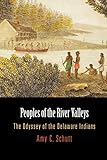Peoples of the River Valleys : The Odyssey of the Delaware Indians / Amy C. Schutt.
Material type: TextSeries: Early American StudiesPublisher: Philadelphia : University of Pennsylvania Press, [2013]Copyright date: ©2007Description: 1 online resource (264 p.) : 14 illusContent type:
TextSeries: Early American StudiesPublisher: Philadelphia : University of Pennsylvania Press, [2013]Copyright date: ©2007Description: 1 online resource (264 p.) : 14 illusContent type: - 9780812220247
- 9780812203790
- 974.004/97345
- online - DeGruyter
- Issued also in print.
| Item type | Current library | Call number | URL | Status | Notes | Barcode | |
|---|---|---|---|---|---|---|---|
 eBook
eBook
|
Biblioteca "Angelicum" Pont. Univ. S.Tommaso d'Aquino Nuvola online | online - DeGruyter (Browse shelf(Opens below)) | Online access | Not for loan (Accesso limitato) | Accesso per gli utenti autorizzati / Access for authorized users | (dgr)9780812203790 |
Frontmatter -- Contents -- Prologue "Sachems from nine different places" -- Chapter 1. Communities and Kin -- Chapter 2. Reorganizations and Relationships in the Hudson and Delaware Valleys, 1609-82 -- 'He knew the best how to order them' -- Chapter 3. Sharing Lands and Asserting Rights in the Face of Pennsylvania's Expansion, 1682-1742 -- Chapter 4. Networks, Alliances, and Power, 1742-65 -- "All the people which inhabit this Continent" -- Chapter 5. Defining Delawares, 1765-74 -- Chapter 6. Striving for Unity with Diversity, 1768-83 -- Epilogue. "Sit down by us as a nation" -- Abbreviations -- Notes -- Index -- Acknowledgments
restricted access online access with authorization star
http://purl.org/coar/access_right/c_16ec
Seventeenth-century Indians from the Delaware and lower Hudson valleys organized their lives around small-scale groupings of kin and communities. Living through epidemics, warfare, economic change, and physical dispossession, survivors from these peoples came together in new locations, especially the eighteenth-century Susquehanna and Ohio River valleys. In the process, they did not abandon kin and community orientations, but they increasingly defined a role for themselves as Delaware Indians in early American society.Peoples of the River Valleys offers a fresh interpretation of the history of the Delaware, or Lenape, Indians in the context of events in the mid-Atlantic region and the Ohio Valley. It focuses on a broad and significant period: 1609-1783, including the years of Dutch, Swedish, and English colonization and the American Revolution. An epilogue takes the Delawares' story into the mid-nineteenth century.Amy C. Schutt examines important themes in Native American history-mediation and alliance formation-and shows their crucial role in the development of the Delawares as a people. She goes beyond familiar questions about Indian-European relations and examines how Indian-Indian associations were a major factor in the history of the Delawares. Drawing extensively upon primary sources, including treaty minutes, deeds, and Moravian mission records, Schutt reveals that Delawares approached alliances as a tool for survival at a time when Euro-Americans were encroaching on Native lands. As relations with colonists were frequently troubled, Delawares often turned instead to form alliances with other Delawares and non-Delaware Indians with whom they shared territories and resources. In vivid detail, Peoples of the River Valleys shows the link between the Delawares' approaches to land and the relationships they constructed on the land.
Issued also in print.
Mode of access: Internet via World Wide Web.
In English.
Description based on online resource; title from PDF title page (publisher's Web site, viewed 24. Apr 2022)


